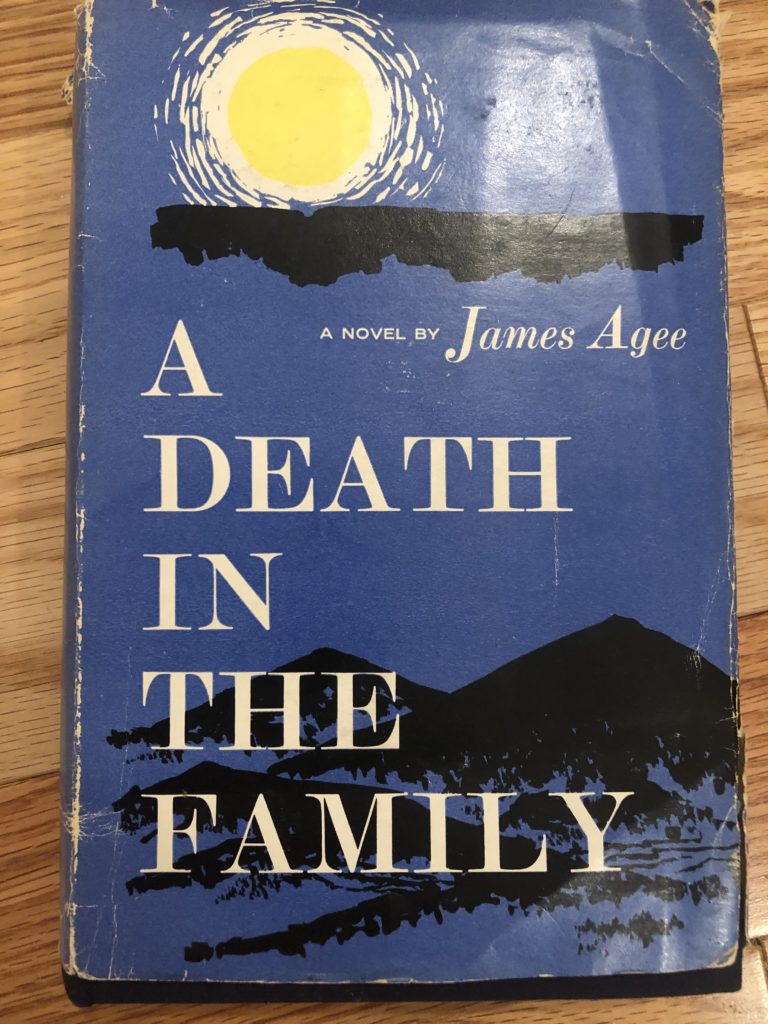A DEATH IN THE FAMILY
 A DEATH IN THE FAMILY, BY JAMES AGEE, PUBLISHED IN 1938
A DEATH IN THE FAMILY, BY JAMES AGEE, PUBLISHED IN 1938
There are two tragedies associated with this Pulitzer Prize winning novel: the death that is central to the story and the fact that the novel had to be published, and the prize awarded, posthumously. Agee’s fatal heart attack, in a taxicab on the way to his doctor at age 45, silenced one of the finest American writers of the 20th century. You may have read Let Us Now Praise Famous Men, with photographs by Walker Evans, documenting the lives of sharecroppers during the great depression, and if you are of a certain age, you may have watched Humphry Bogart in The African Queen, screenplay by James Agee, and I guarantee that anyone who has read his short story, A Mother’s Tale, will never forget it.
A Death in The family is autobiographical. When Agee was six years old, his father was killed in a car accident on his way to visit his father, James’ grandfather. In the novel, Jay Follett is killed trying to get home from a visit to his father on time to say goodnight to his six-year-old son Rufus and his younger daughter Catherine.
The great value of of this novel is that it engenders a level of empathy for the grief of the survivors that is both uplifting and so harrowing that this reader could read only a short section at a time. I gave myself recesses not available to Jay’s wife Mary, her two children and other members of the extended family. When we say to a grieving friend, “I wish I could share your burden,” we are saying we are willing to participate in your tragedy, to suffer and do that heavy lifting. Well, here’s the opportunity to do these things, at least vicariously – just read the book.
The genius of A Death in The Family comes not from telling about the accident that kills Jay Follett – that is told indirectly by those who go to the site of the accident and figure out how it happened- but instead, by telling of the emotional impact on Mary, the two children, especially Rufus, and others in the family, citizens of a small town in Tennessee. Via Agee’s lyrical prose, often italicized for that heightened intensity we see also in much of Faulkner’s writing, we can feel what Mary and her children feel. We join Mary and her aunt through the long night to find out whether Jay was just seriously injured or dead, and we are there with her when his death is confirmed, and with her too in the morning when she tells her two children who want to know where their father is. We are allowed an intimacy with the mind and heart of a six-year-old boy as Rufus gradually absorbs the brute fact that his father is gone from him forever.
For years A Death In The Family stayed on my bookshelves unread. Who needs to read about a death in a family? What’s there for us to learn after experiencing that loss ourselves, firsthand? Now I feel blessed to have finally read it. To be as empathetic as this book allows us to be is to find our better selves, and to feel the love for the lost father and husband and for each other that Mary, Rufus, Catherine and various aunts, uncles and grandparents feel confirms the immeasurable value of each person’s life. There is value in the paradox that the random, meaningless death of her husband that causes Mary to question her religious faith and confirms her brother’s apostacy, is made to be uplifting by a writer’s interpretation of his own experience.
Send not to know for whom the bell tolls, John Dunne said in a famous sermon long ago in St Paul’s Cathedral in London. It tolls for thee. James Agee said this too, without sermonizing, in A Death in The Family, one of the great American novels.
